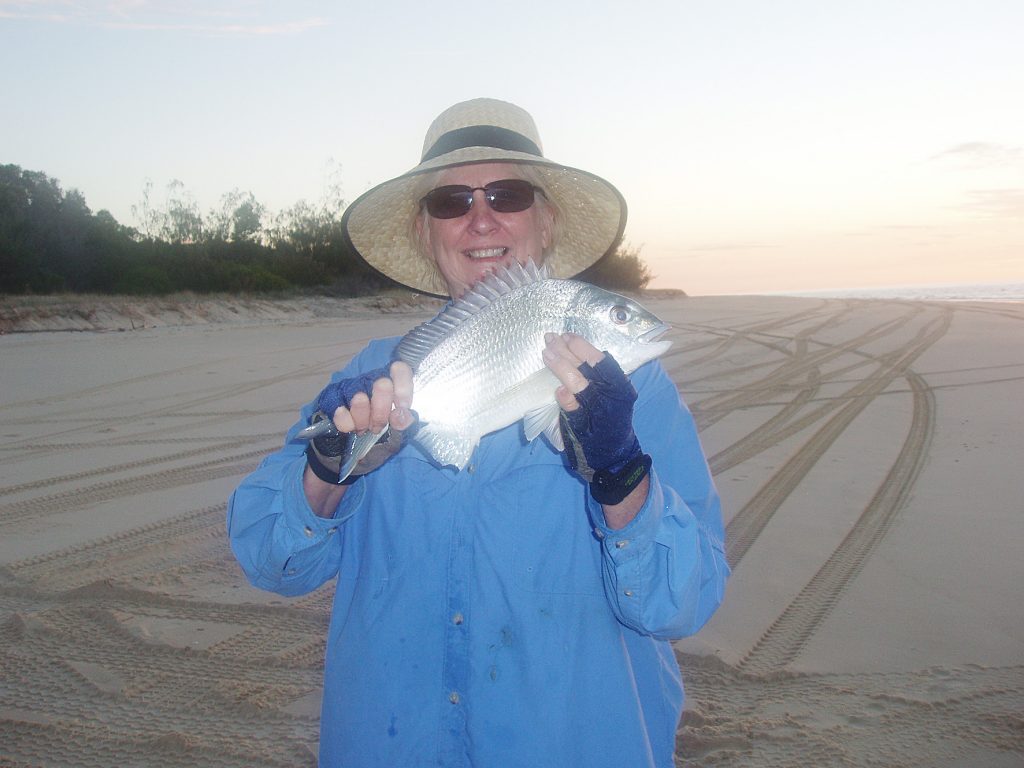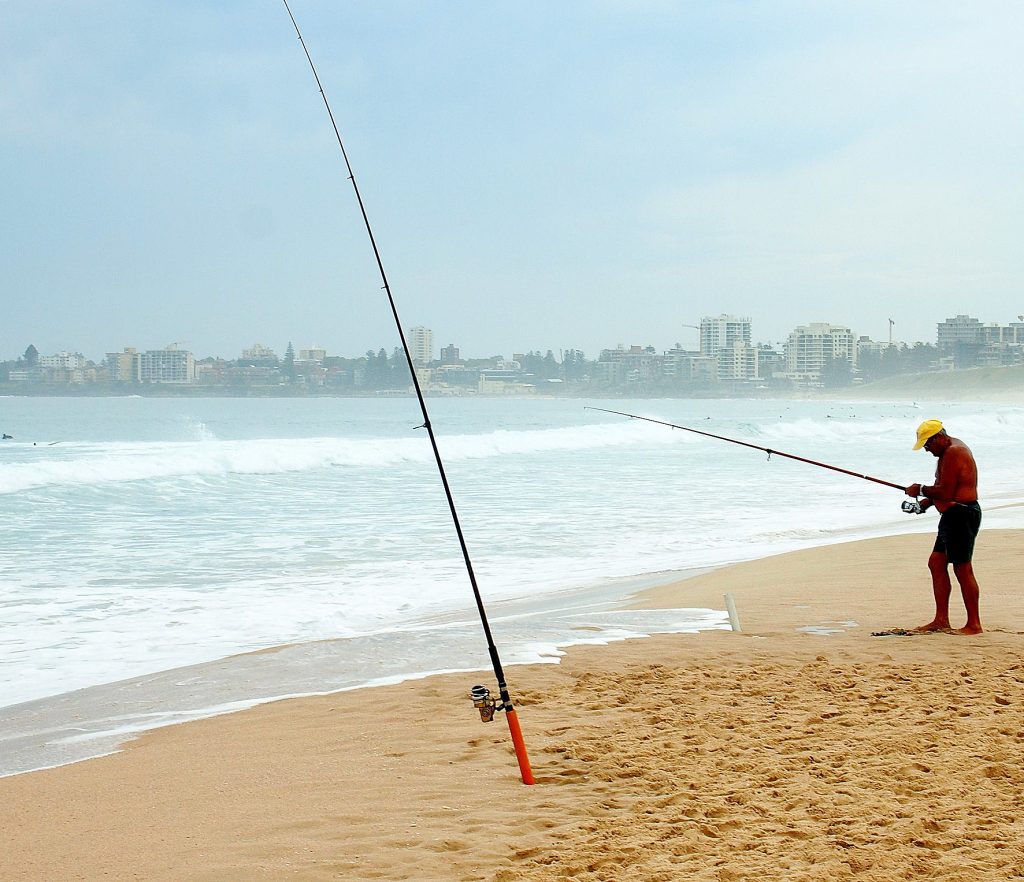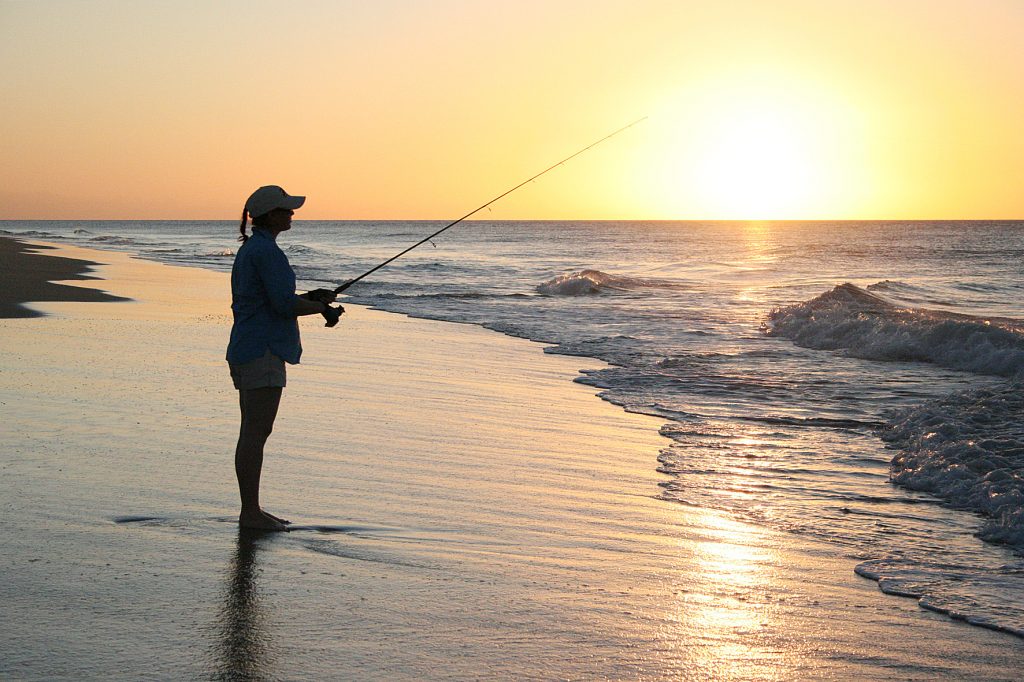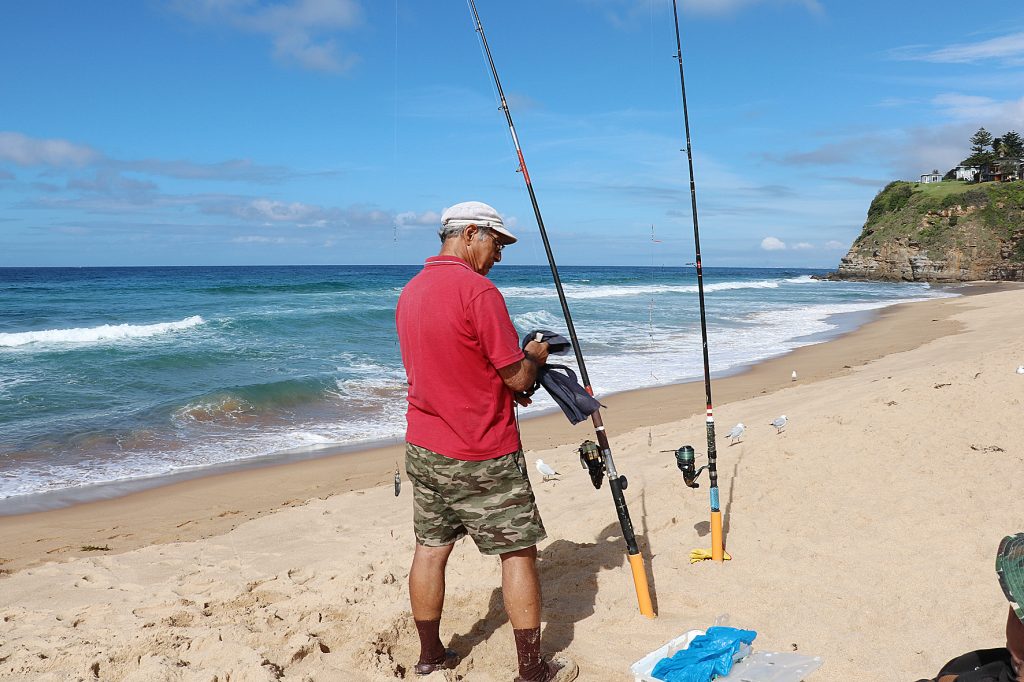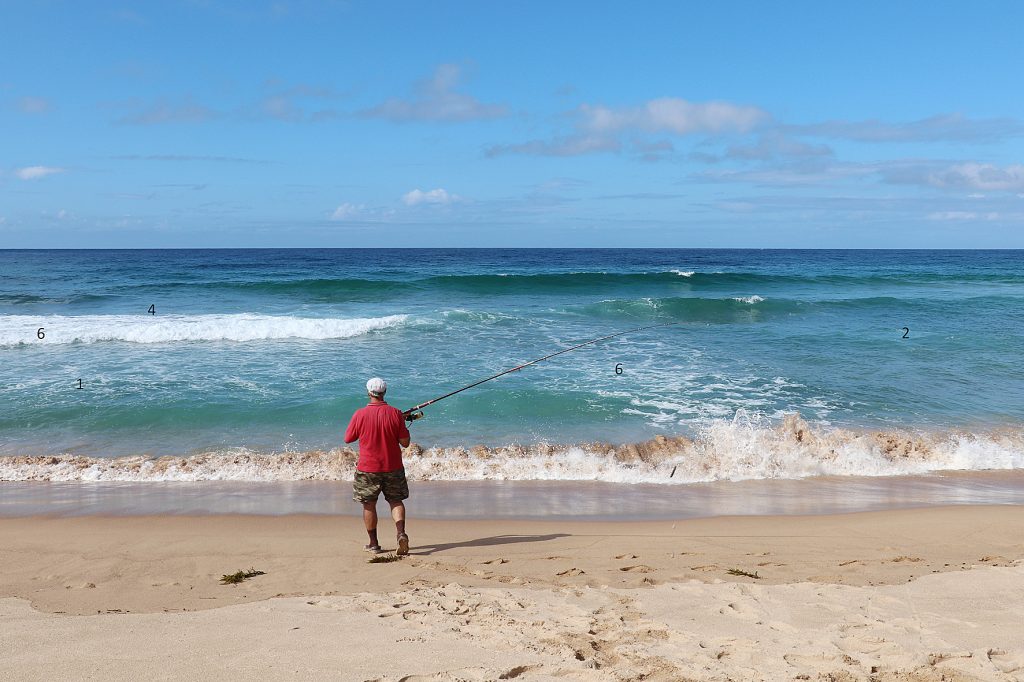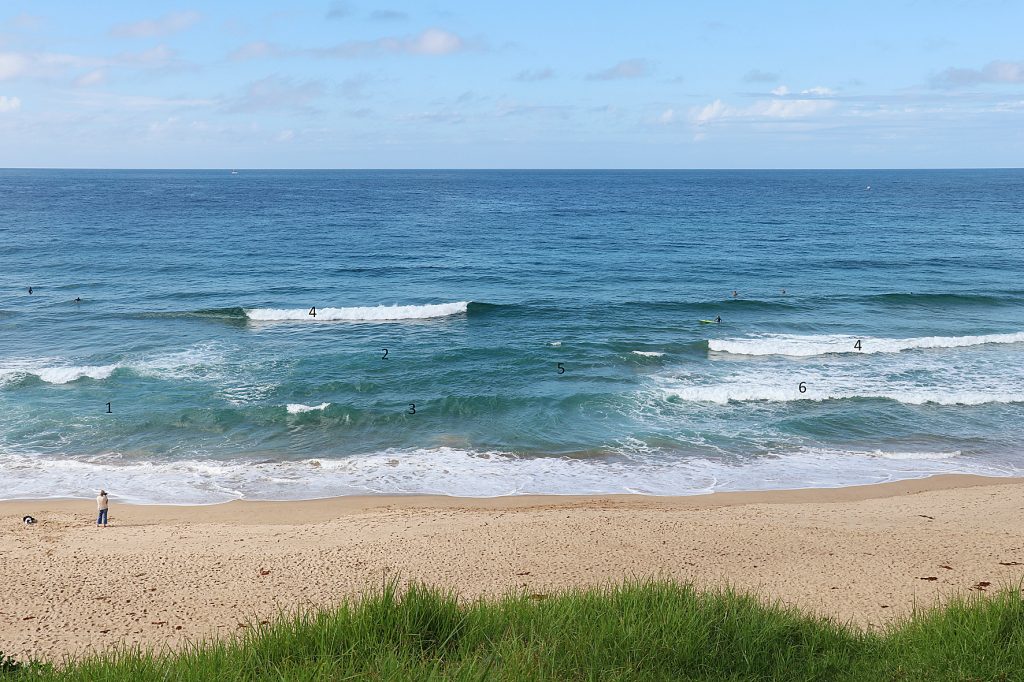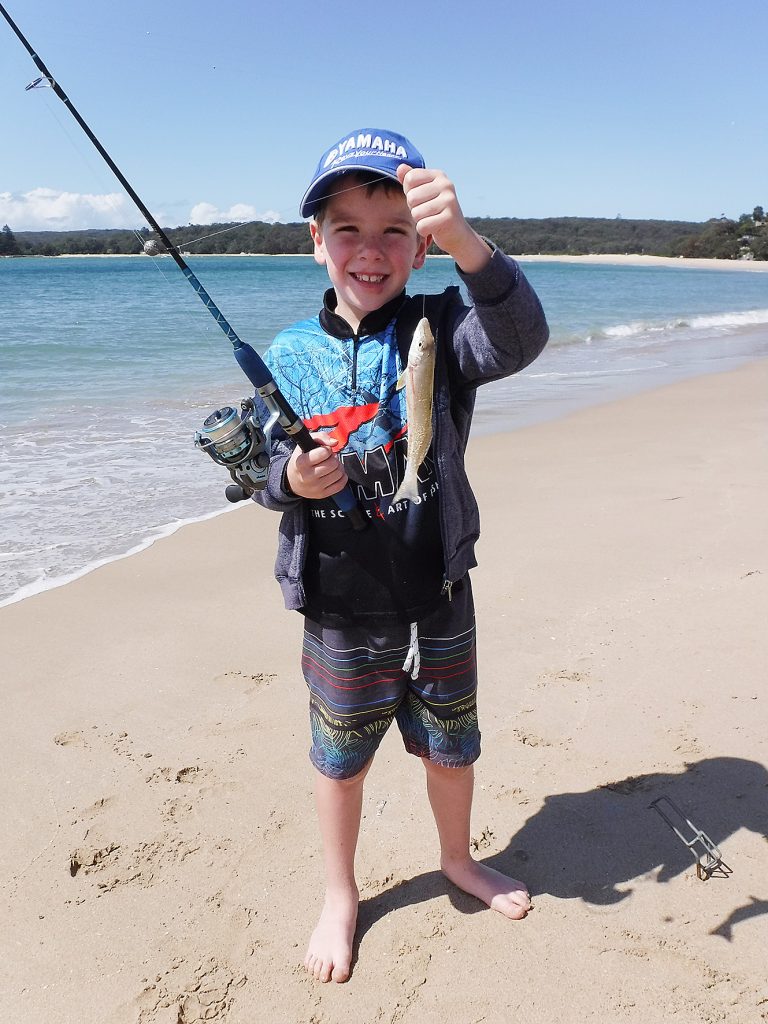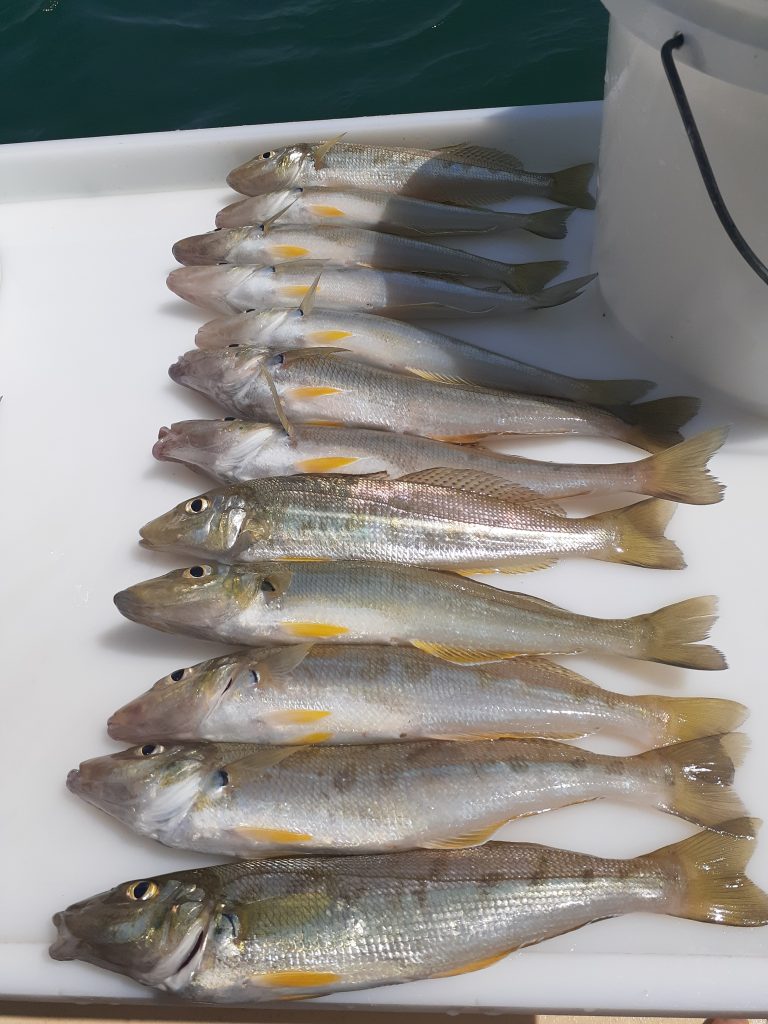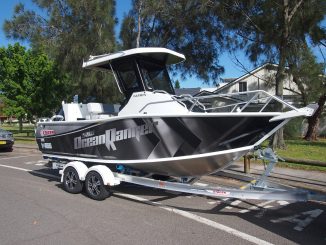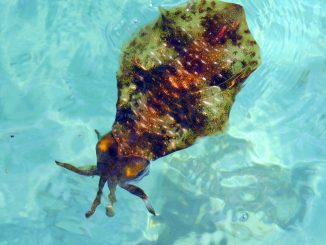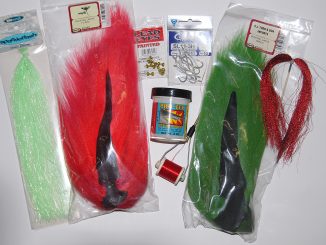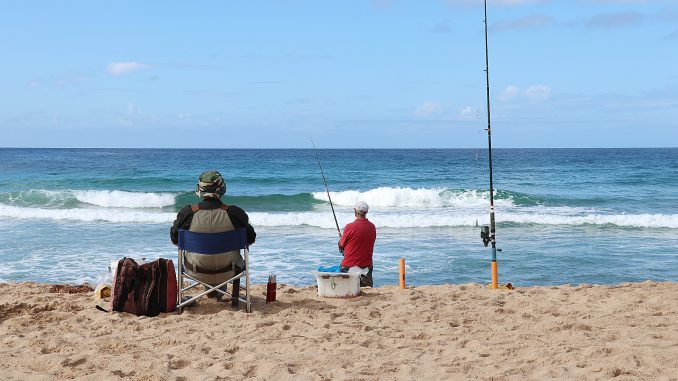
by Gary Brown •
Sand whiting (sillago ciliate) are a member of the family sillaginidae and are also be known as summer whiting, silver whiting and blue-nose whiting in NSW. They are readily found along most of the sandy beaches on the East Coast.
They are silvery white in colour, with plain yellowish sides and are fairly long and slender. They feed on worms, small crabs, yabbies, prawns and pipis. They use their conical snout to forage through sand and mud.
Not all beaches that whiting inhabit are the same, but what they will have is a similar characteristics from time to time, which can be easily identified once you have worked out once you know what they are and how to get the best out of them.
Those characteristics come in the form of gutters or channels, holes, sand spits, sand bars, rips and white water and to help you out I have taken a couple of photos of beaches and numbered them so that you can actually see what I am talking about.
Now whether you refer to them as (1) gutters or channels, they can run parallel or at 90° to the shoreline and be easily distinguished by white water that has formed from a wave braking into shallow water. They can be either deep or shallow, short or long and are what I call a fish highway, as fish will travel up and down looking for a feed.
A hole (2) on a beach is not to be confused with a gutter or channel. Holes at times can be hard to identify by a novice beach angler, especially during the top of the tide. They can be as large as house or as small as a car and can be fished right throughout the tides. They may only be only a few centimetres or a couple of metres deep.
Sand spits (3) are usually a narrow section of sand that runs from the shore out into the surf zone. They can be found on the edge of gutters, channels and holes and can be an access point to more productive areas at low tide. At low tide these sand spits can also be a very productive place to look for beachworms. Care does need to be taken when fishing off these spits, as the wave motion and tide can collapse them.
Large, medium and small sand bars (4) are easily distinguished by the waves that break on or over them.
Rips (5) are caused by the current and tide and may run parallel, at 90° to the beach or at the end of a beach where the sand meets the rocks. Rips when used properly can be a big asset to the beach angler, as it can be used to carry the bait out much further than you may be able to cast.
White water (6) is formed with the break of a wave either on a beach, a sand bar or a spit. It is this white water that the fish will either use as cover from larger predators or as cover to chase prey.
BAIT
When targeting whiting off the beach the main baits that I prefer to use are the beach, tube and squirt worms, pipis, live pink nippers and small strips of freshly caught squid.
Bloodworms
You can use bloodworms in NSW, but due to the ban on the movement of bait between QLD and NSW to prevent the spread of white spot disease, they can be very hard to buy. As far as I know, there is no ban on digging for them in NSW other than DPI Fisheries bans. Check the NSW DPI website to find out more.
Beachworms
Beachworms are my number one bait when fishing off the beach and if I am feeling lazy, I will go and buy them at a local bait shop. Even though I am not the greatest beachwormer, I can usually get myself enough for a session.
A fellow angler from the Far South Coast taught me to put a handful of pilchards into a stocking and then into a keeper bag, as they are oily and will attract the worms. Once the worms have been located, I then use a smaller bag that is attached to my wrist to get the worms to pop their heads up.
I find that there are three critical things when it comes to grabbing the beachworms with your fingers or worm pliers. Firstly, you have to have sand in-between your fingers or pliers and the worm. Secondly you close you fingers or plies just as the worm arches its neck to grab the bait, and thirdly, don’t pull too hard when pulling on the worm out of the sand. I usually go for a second grab down in the sand.
To locate them on a beach you will need to look for a flat sand area rather than a steeply shelving part of the beach. I find that worming during the bottom half of the tide will give me better results.
Pink nippers
Pink nippers are found in most estuary systems throughout Australia. They will vary in size and numbers, depending on how hard the estuary has been hit by other anglers. It is really easy to find them, all you need to do is look for the holes that they leave on the surface of the sand or mud.
You will need to get the technique correct when pumping them to save you time and energy. As the tide is rising over the sand or mud flats, pump where the water has just started to cover the sand or mud. About 4-5 pumps in a hole should do the trick.
If you are pumping for nippers over an area that has water on it, you will need to pump the sand into a sieve, as this will allow you to easily pick the nippers out. Nippers can be pumped on a falling tide. Just follow the water as it recedes.
Pipis
Pipis are not found on all ocean beaches. The are usually seen when the wave is either coming up the beach or receding down it. The pipis will rise up to the top layer of the sand looking for any small morsel that may pass by. They will also use the motion of the waves to move up and down, as well as along the beach. Once you have located one you will usually find a group of them.
Once located it’s not hard to get a few for bait. One way is to twist your feet in the sand and when you feel one, bend down and pick it up.
Squirt worms
Squirt worms are a brilliant bait for many different fish species. The only problems that you may find is that where they are located in an estuary close to you, you may not be allowed to dig or pump for them. When I venture down the South Coast to the Shoalhaven area, I will occasionally pump them. Squirt worms can be located in the same place as nippers. Keep an eye out for small sandy tubes sticking out of the sand.
Squid
When targeting sand whiting with squid I will only use fresh squid that I have caught myself. It has to be cut up into pieces that are 5mm wide and about 25mm long.
TRY THESE TECHNIQUES
There are many scenarios you can find yourself in when chasing whiting, and various techniques you can use to bring them unstuck. I will highlight some of these techniques and scenarios.
• Try casting out your bait, allow it to sink to the bottom and make sure that you have the rod tip down in front of you and that the tip is near the surface of the water. Once it has settled, slowly move the rod tip to your side. This slight continual movement usually gets the whiting excited enough to attack your bait. If you don’t get a bite, then wind in the line so that you have the rod tip out in front of you and repeat the process either back to the shore or at the back of your boat.
• When using worms as bait, put either a small plastic red or pink bead or a length of pink or red plastic tubing above the hook. This will help make the bait look bigger and act as an attractant.
• If you find that you are getting a number of tangles in your rig when using a sinker running down onto a swivel and a long leader, change to a single or double paternoster rig. Making sure that the two hooks cannot hook onto each other.
• Sometimes there is a big possibility of salmon or tailor about, so I will change the sinker on the paternoster rig to a similar weight metal lure. If you happen to miss the whiting bite, you can always speed up your retrieve and probably get a bite from a tailor of salmon. You could also substitute the sinker with a jighead and soft plastics for mulloway and flathead.
• It is not always possible to get beach or tubeworms and there are times when I decide on the spur of the moment to go for a fish. This is when I pull out a small bag of worms that have been soaked in methylated spirits for about 2-3 minutes and then put into the freezer. The great thing about doing this is that the bait doesn’t freeze, as methylated spirits is a liquid made from alcohol and other chemicals. It does not put the fish off from biting the bait at all.
PREFFERED TACKLE
When it comes to rods, for me it has to be one that has a medium to slow taper, is 3-3.6m long and it can be suited either for a small threadline or a 120-125mm side cast reel.
As for the line, I prefer to use 5-6kg Platypus Super 100 monofilament as the mainline and the Platypus Stealth Fluorocarbon leader in 3-4kg.
The running sinkers down onto the swivel range from ball, barrel or bean in a variety of sizes and when I am using the paternoster rig, I will use either snapper, star of plumb bob sinkers (the ones with a swivel attached).
Due to whiting having a small slender under slung mouth, I will tend to use no. 6-4 long shank chemically-sharpened hooks for the worms, nippers and strips of squid. When using pipis, I will use size no. 4-2 circle hooks.
Don’t think that putting on a large swivel will stop line twist. What is usually does is cause more line twist back up the mainline. A size 4 should do the trick when it comes to 5-6kg mainline.
Now that I have given you a bit of an insight on where, how and what I do when it comes to targeting sand whiting off the beach, you can get out there and try it for yourself! Good luck!

